Flower tea is a beverage made by mixing dried flowers (such as roses, jasmine, honeysuckle, etc.) with tea leaves (usually green or white tea) or herbs (such as chrysanthemum, hibiscus). It combines the aroma of flowers with the taste of tea or herbs, creating a unique flavor and visual effect. It is not just a drink but also a symbol of cultural experience and lifestyle.
The process of making flower tea is relatively simple yet delicate: dried flowers are mixed with tea leaves or herbs, allowing the floral aroma to blend with the tea’s flavor. This blend enhances the taste of the tea and gives it different colors and aromas.
Brewing flower tea is usually meticulous, requiring the right water temperature and steeping time to ensure the essence of both the tea leaves and flowers are fully released, presenting the best flavor and visual appeal. Since the flowers used in flower tea are typically natural plants, it is also considered a healthy beverage with medicinal value.
Historical Origins and Development of Flower Tea
The history of flower tea can be traced back to ancient China, particularly during the Song Dynasty, when it became a favored drink among the court and literati. During that time, people began experimenting with combining tea leaves with flowers to enhance both the fragrance and appearance of tea, as well as to explore different flavors and effects.
Over time, flower tea not only spread within China but also became popular in other East Asian countries such as Japan and Korea. Today, flower tea has become part of global tea culture due to its unique flavor and visual appeal, widely loved and appreciated.
In various tea cultures, flower tea has gradually developed into a luxurious indulgence and a healthy choice, offering a unique sensory experience and symbolizing a pursuit of nature and a beautiful life.
Types of Flower Tea
As a unique beverage that combines flowers with tea leaves or herbs, flower tea comes in a diverse array of types, each bringing different aromas and flavors, making it an integral part of tea culture.
1. Common Flower Teas
Common flower teas refer to those widely used in traditional tea cultures, known for their distinct floral aromas that enhance both the taste and visual appeal of the tea. Here are some common flowers:
- Rose Tea: Renowned for its delicate floral aroma and subtle sweetness. Often blended with white or green tea to impart floral notes and a hint of romance.
- Jasmine Tea: Made by blending jasmine flowers with green tea, it boasts a strong floral fragrance and a refreshing tea flavor, making it a classic in Chinese tea varieties.
- Chrysanthemum Tea: Known for its mild floral aroma and slightly bitter taste, it is often used to regulate emotions and detoxify the body.
These common flower teas not only vary in taste but also offer different medicinal and cosmetic benefits, making them widely loved and used.
2. Specialty Flower Teas
Specialty flower teas are less common but offer unique flavors and benefits, providing a new tea drinking experience and sensation. Here are a few examples:
- Osmanthus Tea: Famous for its strong osmanthus fragrance, often mixed with green tea or oolong tea to bring out a rich floral aroma and a hint of sweetness.
- Honeysuckle Tea: Made by combining honeysuckle with green or white tea, it has cooling properties and is ideal as a summer beverage for clearing heat and detoxifying.
- Lavender Tea: Loved for its gentle floral aroma and calming effects, it is used to aid sleep and relieve stress.
Due to their unique aromas and effects, these specialty flower teas often cater to individual preferences in tea drinking, adding a vibrant aspect to tea culture.
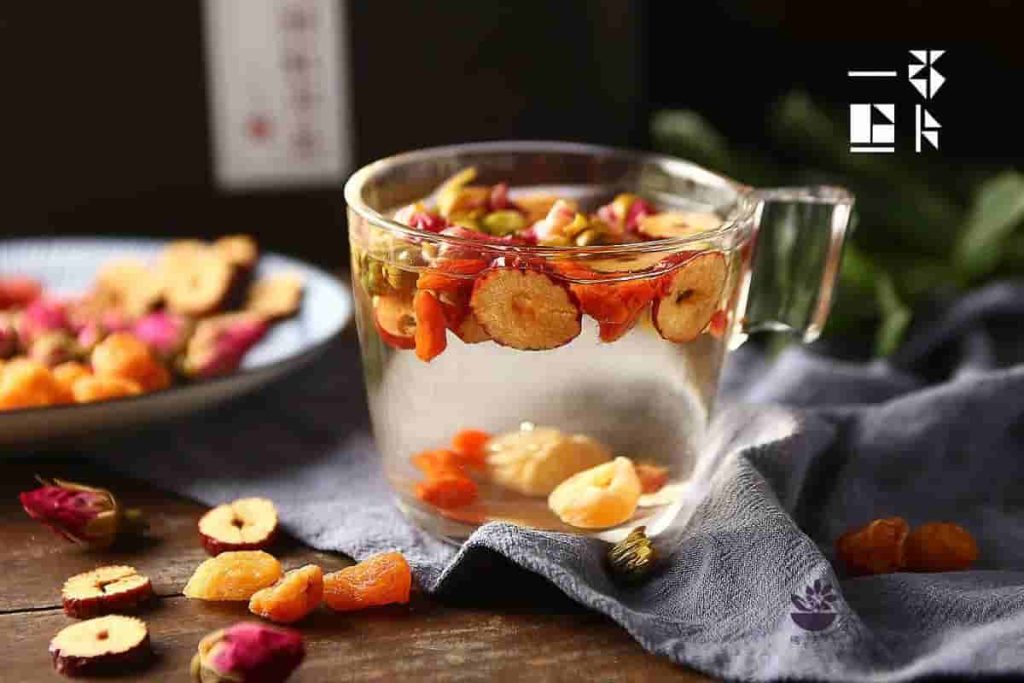
Production Process of Flower Tea
Flower tea is an exquisite beverage that combines flowers with tea leaves or herbs. Its production process involves meticulous steps such as fresh flower picking and processing, blending tea leaves with flowers, and drying and preservation techniques.
1. Fresh Flower Picking and Processing
The production of flower tea begins with selecting high-quality fresh flowers. Commonly chosen flowers include roses, jasmine, chrysanthemums, etc. These flowers are ideally picked when they are either just about to bloom or have just bloomed, to retain their optimal fragrance and nutritional content. During picking, it’s essential to avoid direct sunlight and damp environments to preserve the quality and shelf life of the flowers.
After picking, the fresh flowers undergo processing, including removing impurities, washing, and controlling moisture content. This ensures that the process of blending tea leaves with flowers maintains the quality and stability of the tea.
2. Blending Tea Leaves with Flowers
The blending of tea leaves with flowers is a crucial step in flower tea production. Typically, green tea or white tea is chosen as the base, as it blends well with the floral aromas and flavors of the flowers. The blending process often involves the following methods:
- Mixing Method: Placing dried tea leaves and fresh flowers together to naturally absorb the fragrance and nutrients of the flowers.
- Distillation Method: Using distillation to process tea leaves and flowers together, allowing the tea leaves to fully absorb the essence of the flowers.
- Application Method: Directly applying flower petals or stamens onto dried tea leaves, ensuring direct contact and absorption of floral fragrances.
The choice of blending method influences the final taste and aroma of the flower tea. Tea makers select the appropriate method based on the variety of flower tea and market demands.
3. Drying and Preservation Techniques
After blending, the flower tea undergoes drying and preservation processes to maintain its fragrance and nutritional content. During drying, temperature and humidity levels are carefully controlled. Typically, well-ventilated drying rooms or equipment are used to avoid direct sunlight exposure, which could affect the color and flavor of the flower tea.
Once dried, flower tea requires proper packaging and storage. Common packaging methods include sealed bags, cans, or aluminum foil packaging, which effectively prevent oxygen and moisture intrusion, thus extending the shelf life of the flower tea.
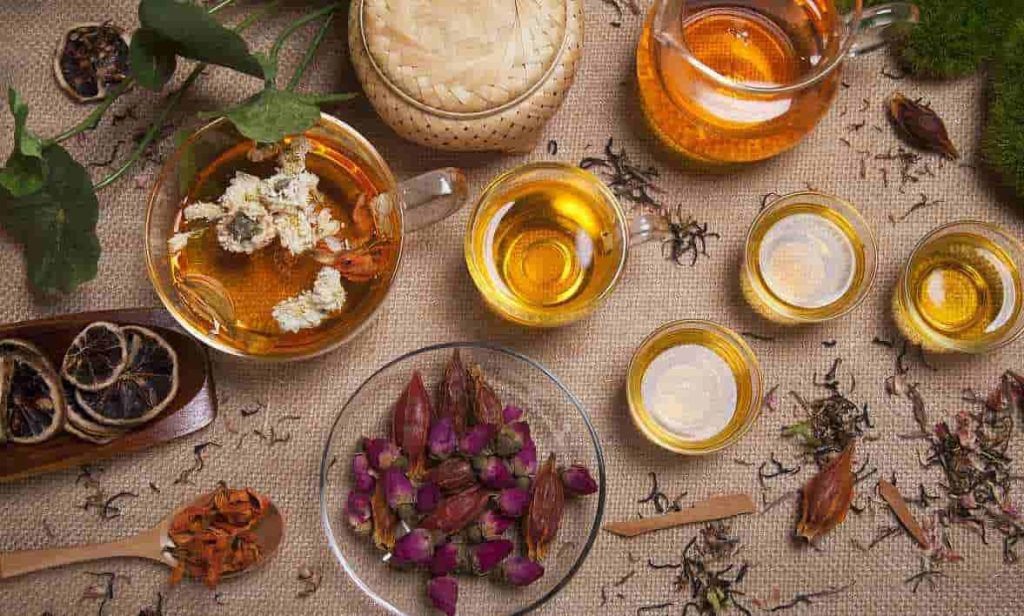
Nutritional Components and Health Benefits of Flower Tea
Flower tea, as a unique beverage that combines flowers with tea leaves or herbs, not only offers distinctive flavors and aromas but also contains a variety of nutritional components that provide several health benefits.
1. Vitamins and Minerals in Flower Tea
The primary nutritional components in flower tea include vitamins, minerals, and unique compounds from the flowers and herbs:
- Vitamins: Different types of flower teas contain various vitamins, but they are generally rich in vitamin C and vitamin E. Vitamin C helps boost immunity and enhances iron absorption, while vitamin E acts as an antioxidant that helps slow down aging.
- Minerals: Common minerals found in flower tea include potassium, magnesium, calcium, and others, which are crucial for maintaining normal nerve and muscle function, bone health, and cellular metabolism.
- Compounds from Flowers and Herbs: Different flowers and herbs have unique compounds. For example, roses contain anthocyanins and aromatic oils, offering benefits such as detoxification and skin moisturizing. Lavender is rich in terpenoids, which have calming and relaxing effects.
2. Health Benefits of Flower Tea
Due to its rich nutritional profile and the specific benefits of flowers and herbs, flower tea provides several health benefits:
- Anti-aging and Skin Care: Flower teas like rose tea and chrysanthemum tea are rich in antioxidants, effectively combating free radicals that damage the skin. They help delay skin aging and maintain skin health and radiance.
- Calming and Sleep Aid: Certain flower teas such as lavender tea and honeysuckle tea have calming and relaxing effects, helping to alleviate anxiety and improve sleep quality, making them beneficial for insomnia and anxiety disorders.
- Digestive Aid: Some flower teas like jasmine tea and chamomile tea contain volatile oils and bitter substances that stimulate digestive fluid secretion, alleviating gastrointestinal discomfort and aiding digestion.
- Detoxification: Flowers such as honeysuckle and chrysanthemum in flower tea contain anti-inflammatory compounds, which help detoxify the body and relieve symptoms of fever and sore throat caused by colds.
Therefore, flower tea not only serves as a delicious beverage but also as a natural choice to promote health, meeting the dual desires of taste and wellness.
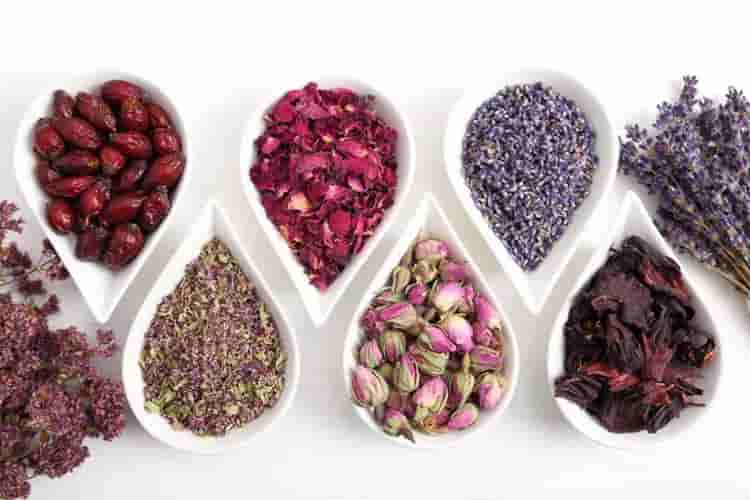
Flower Tea Brewing Methods and Techniques
Flower tea is a unique type of tea that requires attention to water temperature, choice of teaware, and brewing time to ensure optimal flavor and the release of nutritional benefits.
1. Suitable Water Temperature and Teaware Selection
Choosing the right water temperature and teaware is crucial when brewing flower tea:
- Water Temperature: Generally, using water temperatures between 80°C to 90°C (176°F to 194°F) is ideal for brewing flower tea. High temperatures can destroy the aroma and nutritional components of the flowers, while low temperatures may not fully extract the essence from the tea leaves and flowers.
- Teaware: It is recommended to use teaware made of breathable materials such as glass or porcelain. These materials allow you to appreciate the color and visual effects of flower tea better. Avoid using metal teaware, as it may affect the taste and aroma of the tea.
2. Brewing Time and Number of Infusions
The brewing time and number of infusions directly impact the taste and strength of flower tea:
- Brewing Time: Typically, flower tea should be brewed for about 3 to 5 minutes. The exact time can be adjusted according to personal preference; longer steeping times result in a stronger flavor, whereas shorter times yield a lighter taste.
- Number of Infusions: Flower tea can usually be steeped multiple times, with each infusion retaining a certain amount of aroma and flavor. However, ensure each brewing session is within an appropriate time frame to avoid over-extraction and impacting the taste.
3. Brewing with Other Ingredients
Sometimes, pairing flower tea with other ingredients can enhance the flavor profile and health benefits:
- Fruits or Herbs: Adding chopped fresh fruits like lemon or peach, or herbs like mint leaves or ginger, to flower tea can introduce additional flavors and nutritional elements.
- Honey or Sugar: For those who prefer sweetness, adding a small amount of honey or sugar to brewed flower tea can adjust its sweetness level, making the taste more complex.
- Ice: During summer or for those who enjoy cold beverages, adding ice cubes to brewed flower tea creates a refreshing iced flower tea, perfect for cooling down.
When combining flower tea with other ingredients, it’s important to control the amount added to avoid overwhelming the natural aroma and taste of the tea itself.
By mastering these brewing methods and techniques, you can fully enjoy the exquisite flavors and health benefits that flower tea has to offer.
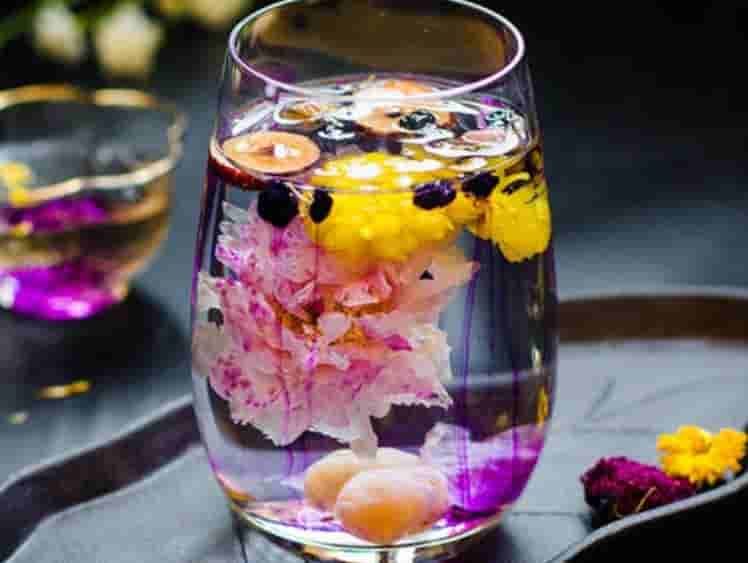
How to Choose High-Quality Flower Tea
Choosing high-quality flower tea allows you to enjoy rich floral aromas and unique flavors while ensuring the nutritional value and quality of your tea drink. Here are key points to consider when purchasing flower tea:
1. Observe Appearance and Color
The appearance and color of flower tea are important indicators of its quality:
- Tea Leaves: High-quality tea leaves should be uniform, intact, glossy, and not dry or damaged. For flower teas based on green tea, the leaves should be bright green or silver-gray, without noticeable yellow or brown hues.
- Flowers: The flowers in flower tea should be whole, undamaged, and brightly colored. For instance, rose petals in rose flower tea should remain vibrant red, without withering or dullness.
2. Smell the Aroma
High-quality flower tea should have a fresh and intense floral aroma that is long-lasting and not overpowering:
- Floral Aroma: By smelling the aroma of flower tea, you can preliminarily judge the freshness and quality of the flowers. Good flower tea should have a pure floral scent without any off-notes or mixed aromas.
- Tea Aroma: Flower tea itself should have a certain tea aroma, such as the refreshing aroma of green tea or the subtle elegance of white tea. These aromas blend with the floral notes to create the unique flavor profile of flower tea.
3. Understand Origin and Brand
Choosing a reputable brand with a good production background and understanding the origin of flower tea are crucial to ensuring the purchase of high-quality products:
- Origin: Different regions for flower tea production may affect the quality of tea leaves and flowers. For example, Yunnan and Fujian provinces in China are renowned for producing high-quality tea leaves, while Hunan and Sichuan are known for flowers like honeysuckle and lavender.
- Brand: Opt for well-known brands with good reputations, as they typically offer more stable and high-quality flower tea products. You can learn about a brand’s reputation and user reviews through online searches, social media, or word of mouth recommendations.
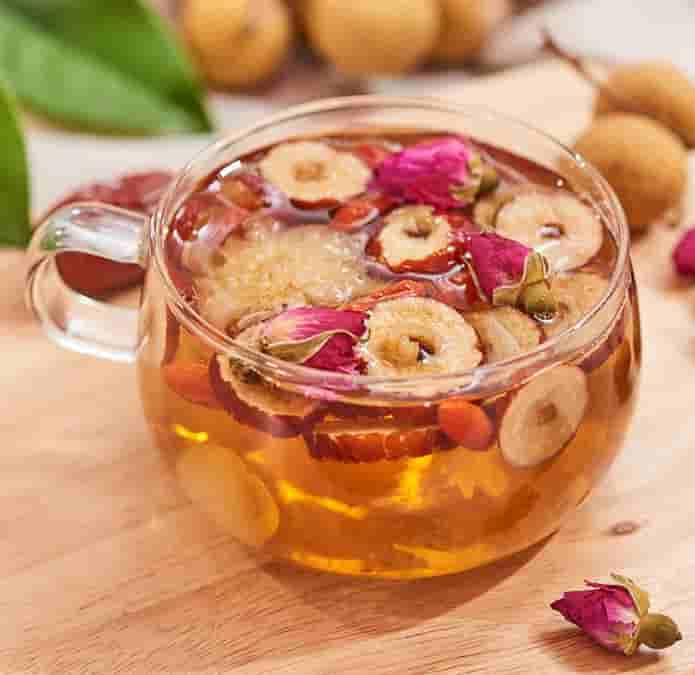
Flower Tea Consumption Taboos and Precautions
As a special type of tea with rich aroma and various health benefits, flower tea also comes with considerations for individuals who should avoid it and precautions to be aware of.
1. Unsuitable Groups
Although flower tea is generally safe for most people, the following groups should pay special attention when consuming it:
- Pregnant and Nursing Women: Some flower teas may contain phytochemicals such as volatile oils found in osmanthus tea, which could potentially have adverse effects on pregnant and nursing women. It is advisable to choose under medical guidance.
- Children: Due to their developing digestive systems and metabolism, excessive consumption of flower tea, especially those containing caffeine or other stimulating ingredients, may affect children’s health. It’s best to avoid giving flower tea to children.
- Individuals Allergic to Certain Flowers or Herbs: Some people may be allergic to specific flowers or herbs used in flower tea, such as chrysanthemum. When selecting flower tea, consider personal allergy history, such as pollen allergies or reactions to other flowers.
2. Side Effects of Excessive Consumption
While flower tea offers various health benefits, excessive consumption can also lead to certain side effects:
- Caffeine Content: Some flower teas, such as rose flower tea or green tea-based flower teas like osmanthus green tea, may contain caffeine. Excessive caffeine intake can cause adverse effects such as insomnia, palpitations, or headaches.
- Pharmacological Effects: Some flower teas contain medicinal ingredients; for example, honeysuckle tea has detoxifying properties. Prolonged or excessive consumption may lead to adverse effects such as increased burden on the liver and kidneys or digestive issues.
- Nutrient Overload: While flower teas are rich in vitamins and minerals, excessive consumption may lead to nutrient overload, affecting the body’s balance of nutrients.
Precautions
In addition to the aforementioned groups and potential side effects of excessive consumption, consider the following precautions when consuming flower tea:
- Choose Fresh Flower Tea: When purchasing, opt for fresh and reputable flower tea products to ensure quality and safety.
- Be Cautious with Other Medications: If taking medications, especially prescription drugs or herbal remedies, consult a doctor before consuming flower tea to avoid potential interactions.
- Monitor Personal Reaction: When trying flower tea for the first time, start with a moderate amount and pay attention to personal reactions. If any discomfort occurs, discontinue use immediately and seek medical advice.